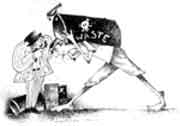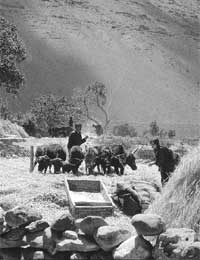
Under siege
India, seen as a dumpyard by the developed countries for toxic wastes, is under pressure not to ratify the Basel Ban

India, seen as a dumpyard by the developed countries for toxic wastes, is under pressure not to ratify the Basel Ban

Can the cold logic of statistics ever breathe life into yardsticks for deciding whether a nation has done good or bad by its people?

CII study recommends greater private role in India's healthcare sector, but the document centres around the lucrative tertiary care market only
Four oil companies Indian Oil Corporation, Hindustan Petroleum Corporation, Bharat Petroleum Corporation and Reliance Industries have signed a memorandum with industry and scientific institutions

Vasectomy may not be all it's cut out to be

The bene fits of hormone replacement therapy in post menopausal women outweigh its side effects

Are mobile phones safe?

Premature deaths and disease caused by a polluted environment is the most pressing problem in the world today, says a WHO report prepared for the Earth Summit

Though all living beings have a finite life span, beyond a certain age, the probability of survival becomes unpredictable.
The UFA (Universal Film Studios) Fabrik in the German city of Berlin is a unique experiment in urban living. The former film studio is now home to a comm unity of 50. Having acquired a worldwide

"TO BE or not to be": one is immediately struck by the stark bipolarity suggested by the title. The show, presented by Max Mueller Bhavan and the World Wide Fund (WWF) for Nature, is about the
Chidambaram may try to shift attention from high prices of essentials If everybody, including political parties, is talking about farmers it must be election time. Close to election, it has become more or less a trend for the government of the day to announce sops for the agriculture and rural sectors in its budget proposals. So even while the common man has to swallow the bitter pill of the "inevitable' petrol and diesel hike before the 2008-09 budget, there is a promise of a "populist budget' for farmers and the aam garib aadmi this year. Low growth rate With several States going to the polls this year ahead of the next year's Lok Sabha election, there may be an attempt to shift the attention from the high prices of essential commodities, low growth rate (2.3 per cent in the 10th Plan) in agriculture, the disconnect between a high Gross Domestic Product and the rural sector, with problems of displacement, migration, unemployment, suicides by farmers and impending food crisis. This budget is most likely to convey the last ditch attempt of the Congress-led United Progressive Alliance (UPA) government to redeem itself from the scars caused in the countryside by farmer suicides and dispossession of rural families on account of Special Economic Zones and other industrialisation projects. Without doubt, the Debt Relief Package for Institutional Loanee Farmers (as reported first in The Hindu) and the expansion of the National Rural Employment Guarantee Act (NREGA) Programme will be at the centre of Finance Minister P. Chidambaram's budget proposals. Fertilizer policy Besides, it is expected that he will unveil a rationalised fertilizer policy to encourage balanced use of fertilizers, especially muriates, to revive farm soil. Some succour is also essential for the wives of indebted farmers who committed suicide. There is a growing demand to strengthen the National Agriculture Insurance Scheme (NAIS) and to have a Health Insurance Scheme for farm households, as various surveys showed that most the credits in the informal sector were not only farming related but also to meet the requirements of health, celebrations and even life-style. From all accounts, the pilot weather-based crop insurance may be expanded. Fund requirements It is estimated that the total fund requirement for the expansion of the NREGA from the present 330 districts to 600-odd will be about Rs. 16,000 crore. On the other hand, the debt relief, covering an estimated 35 per cent farmers who had availed themselves of bank loans, is estimated at Rs. 40,000 crore in the first year. The Union government will pay off the dues to banks. A Price Stabilisation Fund is also proposed to be set up with contributions from the government, banks and farmers. Well-placed sources hinted that the Finance Minister may cull out unspent funds from social sectors such as rural development, education and health to partially meet the requirement of the Farmers' Debt Relief Package. It is anybody's guess if the Minister will reduce the interest rate on farm loans from the current 7 to 4 per cent as recommended by the National Commission on Farmers. There is also a demand to raise the credit limit under the Kisan Credit Card scheme. There is an expectation that enhanced budgetary support will continue for the flagship rural programmes, including the swarozgar yojana (self-self groups), Pradhan Mantri Gram Sadak Yojana, Indira Awas Yojana and the Drinking Water Supply programme. The highest increase, however, is expected in the Land Resources Programme under the Integrated Wasteland Management Programme. In the agriculture sector, allocation has to be enhanced for the Rashtriya Krishi Vikas Yojana to enhance production and productivity and to the National Food Security Mission to increase the output of rice, wheat and pulses. Both schemes are new and yet to take off. Irrigation schemes, horticulture mission and agriculture research will get the customary support, as growth in farm "allied sectors' comes from these areas. The National Rainfed Area Authority is most certainly likely to get financial support. Food subsidy The food subsidy bill is likely to cross the Rs 30,000 crore-mark. This is due to the wide difference between the minimum support prices (MSP) paid to farmers and the central issue price of grains sold through the Public Distribution System, as well as on account of the food grains import bill. The subsidy bill to go up further as the food grain stocks are expected to dwindle by April 1, possibly resulting in more imports. With apprehensions of an avian influenza pandemic, a comprehensive rehabilitation package for the poultry industry and bird flu-affected farmers, as part of a Bio-Security Policy, will be announced in the budget, if not earlier. However, the package may include only such poultry farmers, who get linked to institutional poultry farms and the industry. It remains to be seen how the government's packages will play out for the thousands of those in the informal sector who do not have the income and the collateral to avail themselves of institutional loans. Funds utilisation It is expected that in this last year of the UPA government's regime, the emphasis will be on consolidation, with focus on better implementation, monitoring and utilisation of funds. In particular, the Congress has shown signs of being zealous of taking credit for the central funds made available to States, to reap a harvest during election time. The biggest challenge, however, is making agriculture viable for the 82 per cent small and marginal farmers and bailing them out of the clutches of the informal system of borrowing.

THE book is a compilation of 42 papers contributed by social, physical and environment scientists who are working with issues that confront the Himalayas. The first three papers deal with the
ZAFRULLAH Chowdhury draws inspiration as much from Hippocrates as from Mao Zedong. To the first, he owes his medical ideals and to the second, his taking up a rifle to fight in Bangladesh's war of liberation in 1971. <br><br> Bangladesh owes a lot to Ch
Diabetes can take the life out of life

Hair found at ancient sites can reveal the lifestyles of our ancestors

Can Indian traditional medicines transfer their ancient efficacy to the modern era?
If the proliferation of diseases and afflictions to do with lifestyles wasn't enough to give you palpitations at night, here's one more. It's called eco-anxiety. Al Gore has no idea of the havoc he has wreaked upon an unsuspecting world. His heart-stopping warning in his documentary An Inconvenient Truth that only 10 years remain to avoid an environmental catastrophe has only added to the growing number of people worrying themselves sick over issues like global warming, pesticides in food, nuclear waste, vehicle emissions and carbon footprints. In fact, eco-anxiety has even created a new breed of professionals: eco-therapists who counsel patients on making environmentally friendly lifestyle changes. The fears of the eco-anxious are fuelled by excessive and often hysterical media coverage of doomsday scenarios like the one outlined by Gore. In fact, we have a new phrase to describe such coverage: climate porn! The word was created after the US-based Institute for Policy Research analysed hundreds of media articles, news clips and TV ads on the issue. Climate porn refers to the use of apocalyptic language to describe the challenges posed by climate change. Pornography or not, what it has achieved is to give most people on the planet a serious complex about their contribution to global warming and the inevitable retribution that the environmental gods will hurl down on them from above. Image As a socially conscious citizen, my ecoangst has really changed a lot of things I took for granted. I work for a widely circulated weekly newsmagazine that prints on paper made from trees cut down in a forest somewhere. Am I committing a mortal sin each time I write? Should I petition the publisher to reduce the number of pages? It's a Catch-22 situation, similar to the feeling I get when I climb into my gas-guzzling car every morning. Shouldn't I be cycling to work instead? Actually, considering distance and time, that would mean waking up at 4 a.m. and getting home at 9 p.m. which is hardly conducive to good health and quality time at home. I also turn pale when I look at the greens sold by my local vegetable vendor. What foul pesticides have gone into their preservation and why do they look so unnaturally green, or yellow, or red? So, would it be better to reduce my living space and plant a vegetable garden even if it means sacrificing a much-loved and much used balcony? My best friend's apartment is on the 17th floor. Could I reduce electricity consumption by taking the stairs or would I be inviting a seizure? Going green and saving the planet is all very laudable but the anxiety is killing.

A diet low in starch could be one of the reasons for diabetes in women
At the end of day, the biggest <br>problem is the lack of public pressure.<br>Indian people think very little about<br> their health till they fall ill <br>